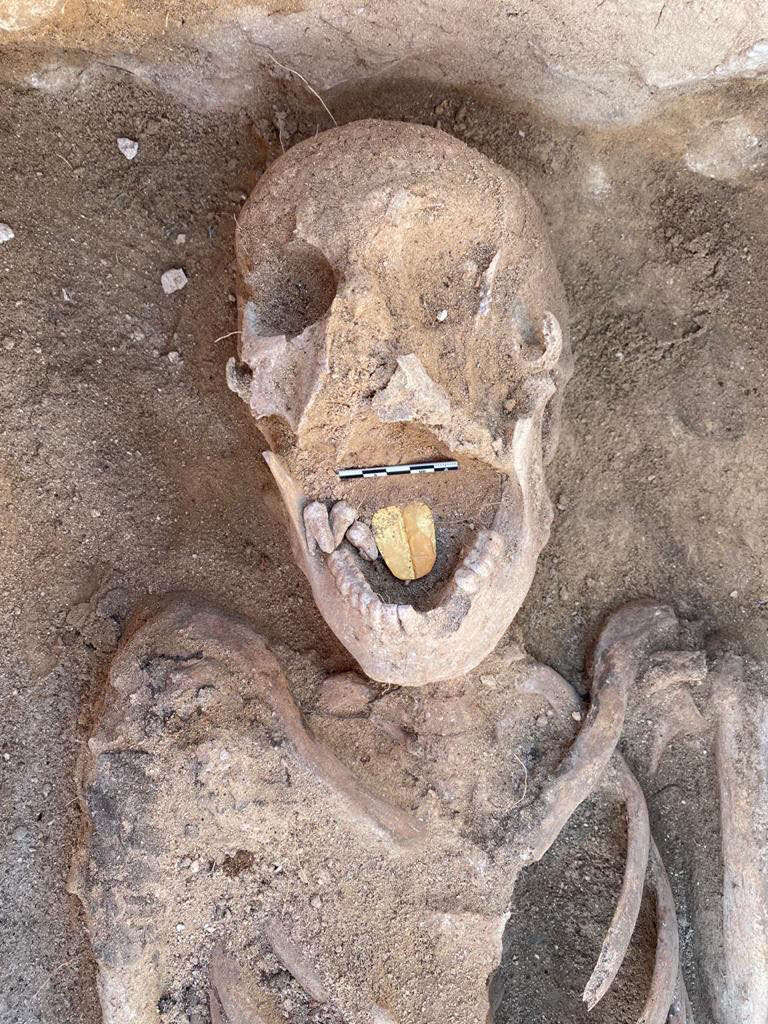Create a free profile to get unlimited access to exclusive videos, sweepstakes, and more!
Could the mummy with the golden tongue speak again in the afterlife?

In Egypt, ancient mysteries are always emerging from the sands of time. The recent excavation of a Roman Period site known as Taposiris Magna, led by Egyptologist Kathleen Martinez, has yielded many fascinating finds, but the one that possibly stood out the most was a mummy with a golden tongue.
Could this person have been an eloquent speaker in life? Were they thought to have been able to speak to the gods or even turn into a god after their death? The ritual Opening of the Mouth ceremony that was performed after mummification made sure that the deceased would be able to see, hear, eat, drink, breathe, and, of course, speak again in the afterlife. That still doesn't explain why so many other elite who passed on did not have their tongues gilded.
“This is a lovely find, very much in keeping with burials of the time,” Egyptologist Salima Ikram, who was not involved in this excavation but has led others that unearthed many exceptional tombs and artifacts, told SYFY WIRE. “Several gold tongue amulets are known from the period, all the better to protect the delicate soft tissue that might be destroyed after death, and to allow the deceased to better answer the gods.”
Mummification in itself was expensive, and forget anything that went over and above just the preservation process. Never mind a fancy tomb. There has been evidence of individuals such royal viziers or high priests to the pharaoh, all but royalty themselves, who were lavishly mummified and buried. Grave robbers have unfortunately looted many of these tombs. Though Ikram does not believe the mummy with the golden tongue was a pharaoh, they definitely had a high standing in society for their family to be able to afford such a luxury.
“From the Ptolemaic era into the Roman Period, gilding among royalty and some of the elite was very common,” she said. “Hands, nails, and even faces were gilded, but we have so few un-robbed burials.”
Though the practice of gilding was common among the upper echelon of society, the tongue of this unnamed mummy stands out because of what its significance could be. Many cultures have their own legends of individuals who were said to have metaphorically “golden tongues”. Saint John Chrysostom of Antioch was given a name that literally translates from the Greek to “golden mouth” — chryso meaning “gold” or “golden” and stom meaning “mouth” — because of the power with which he spoke.
Ancient Egypt’s answer to such stories is a Middle Kingdom tale known as “The Eloquent Peasant”. It tells of the peasant Khun-Anup, who is tricked into giving landowner Nemtynakht (who was already beyond rich) everything he had and then beats him. He pleads to Nemtynakht with such eloquence that he is taken to the palace just so the pharaoh can listen to him for speech inspiration. Though the pharaoh does have an ulterior motive and doesn't seem to mind committing plagiarism, he eventually seizes all the landowner’s possessions and hands them over to the humble peasant who used his tongue instead of his fist.
Maybe Khun-Anup was real, maybe he wasn’t. While the story highlights the importance of justice in Egyptian society, the peasant’s way of speaking shows that there must have also been an appreciation for beautiful speech.
Whether the mummy with the golden tongue was an eloquent speaker remains unknown, but it is possible. This being a Roman Period mummy also has its own significance. The Romans may have associated the gilding of this individual’s tongue with speaking to the gods, and deification, or the transformation of a human into a god in the afterlife. The Egyptians already believed in the deification of royalty after death, but some people of high social status were also included. Speaking to the gods or turning into one through a gilded tongue is not out of the realm of possibility.
Another standout find at Taposiris Magna was an exquisite death mask sculpted in the image of the woman it was made in memory of. It covers her body up to just below the bust. Many death masks from the Roman period were made of flat plaster that was then painted with the image of the deceased, but this one almost seems to be living and breathing.
“The plaster mask and chest covering is a beautiful example of its kind, creating an effigy of the woman’s body,” said Ikram.
After further investigation, maybe the mummy with the golden tongue will finally start to tell us its secrets.















